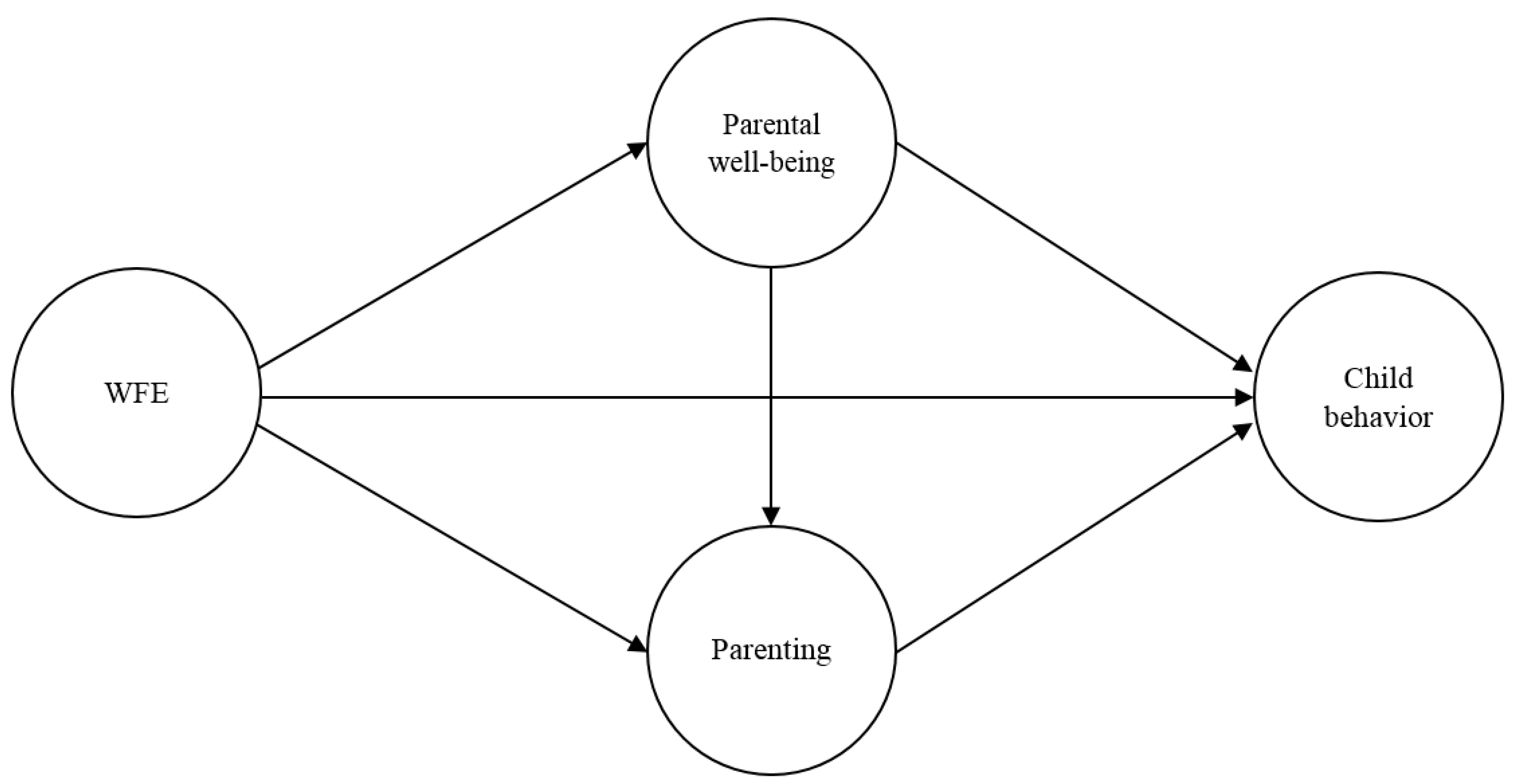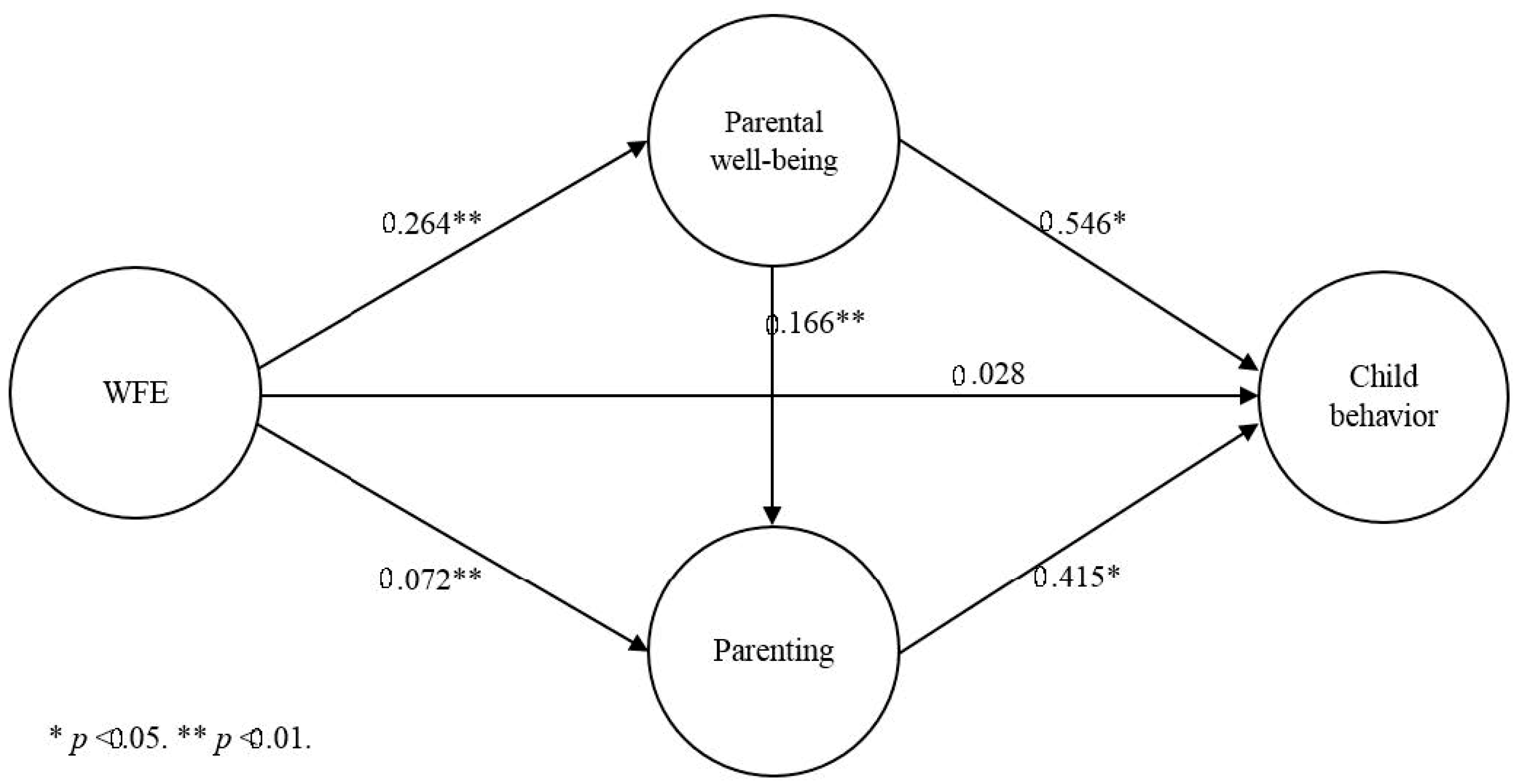The Consequences of Work–Family Enrichment in Families on the Behaviour of Children
Abstract
1. Introduction
2. Literature Overview
2.1. Theoretical Perspective
2.2. Empirical Evidence
3. Method
3.1. Data
3.2. Analytical Strategy
3.3. Measures
4. Results
4.1. Descriptive Results
4.2. Measurement Model: Higher-Order Factors
4.3. Structural Model
5. Discussion
Author Contributions
Funding
Conflicts of Interest
References
- Bastaits, Kim, Koen Ponnet, and Dimitri Mortelmans. 2014. Do Divorced Fathers Matter? The Impact of Parenting Styles of Divorced Fathers on the Well-Being of the Child. Journal of Divorce & Remarriage 55: 363–90. [Google Scholar] [CrossRef]
- Baumrind, Diana. 2016. The Influence of Parenting Style on Adolescent Competence and Substance Use. The Journal of Early Adolescence 11: 56–95. [Google Scholar] [CrossRef]
- Biddle, Bruce J. 1986. Recent Developments in Role Theory. Annual Review of Sociology 12: 67–92. [Google Scholar] [CrossRef]
- Bollen, Kenneth. 1989. Structural Equations with Latent Variables. New York: John Wiley & Sons. [Google Scholar]
- Bronfenbrenner, Urie. 1986. Ecology of the family as a context for human development: Research perspectives. Developmental Psychology 22: 723. [Google Scholar] [CrossRef]
- Carlson, Dawn S., Joseph G. Grzywacz, Merideth Ferguson, Emily M. Hunter, C. Randall Clinch, and Thomas A. Arcury. 2011. Health and turnover of working mothers after childbirth via the work–family interface: An analysis across time. Journal of Applied Psychology 96: 1045. [Google Scholar] [CrossRef]
- Carlson, Dawn S., Emily M. Hunter, Merideth Ferguson, and Dwayne Whitten. 2014. Work–family enrichment and satisfaction: Mediating processes and relative impact of originating and receiving domains. Journal of Management 40: 845–65. [Google Scholar] [CrossRef]
- Chen, Fang Fang, Karen H. Sousa, and Stephen G. West. 2005. Teacher’s Corner: Testing Measurement Invariance of Second-Order Factor Models. Structural Equation Modeling: A Multidisciplinary Journal 12: 471–92. [Google Scholar] [CrossRef]
- Conger, Rand D., Lora Ebert Wallace, Yumei Sun, Ronald L. Simons, Vonnie C. McLoyd, and Gene H. Brody. 2002. Economic pressure in African American families: A replication and extension of the family stress model. Developmental Psychology 38: 179. [Google Scholar] [CrossRef]
- Cooklin, Amanda R., Elizabeth M. Westrupp, Lyndall Strazdins, Rebecca Giallo, Angela Martin, and Jan M. Nicholson. 2015. Mothers’ work–family conflict and enrichment: Associations with parenting quality and couple relationship. Child: Care, Health and Development 41: 266–77. [Google Scholar] [CrossRef]
- Cooklin, Amanda R., Elizabeth M. Westrupp, Lyndall Strazdins, Rebecca Giallo, Angela Martin, and Jan M. Nicholson. 2016. Fathers at work: Work–family conflict, work–family enrichment and parenting in an Australian cohort. Journal of Family Issues 37: 1611–35. [Google Scholar] [CrossRef]
- Darling, Nancy, and Laurence Steinberg. 1993. Parenting Style as Context: An Integrative Model. Psychological Bulletin 113: 487–96. [Google Scholar] [CrossRef]
- Diener, Ed, and Marissa Diener. 2009. Cross-cultural correlates of life satisfaction and self-esteem. In Culture and Well-Being. Berlin/Heidelberg: Springer, pp. 71–91. [Google Scholar]
- Dierckx, Myrte, Dimitri Mortelmans, and Joz Motmans. 2018. Role Ambiguity and Role Conflict among Partners of Trans People. Journal of Family Issues 40: 85–110. [Google Scholar] [CrossRef]
- Dinh, Huong, Amanda R. Cooklin, Liana S. Leach, Elizabeth M. Westrupp, Jan M. Nicholson, and Lyndall Strazdins. 2017. Parents’ transitions into and out of work-family conflict and children’s mental health: Longitudinal influence via family functioning. Social Science & Medicine 194: 42–50. [Google Scholar] [CrossRef]
- Dittrich, Katja, Anna Fuchs, Felix Bermpohl, Justus Meyer, Daniel Führer, Corinna Reichl, Corinna Reck, Dorothea Kluczniok, Michael Kaess, and Catherine Hindi Attar. 2018. Effects of maternal history of depression and early life maltreatment on children’s health-related quality of life. Journal of Affective Disorders 225: 280–88. [Google Scholar] [CrossRef]
- Goodman, Robert. 1997. The Strengths and Difficulties Questionnaire: A research note. Journal of Child Psychology and Psychiatry 38: 581–6. [Google Scholar] [CrossRef]
- Greenhaus, Jeffrey H., and Gary N. Powell. 2006. When work and family are allies: A theory of work-family enrichment. Academy of Management Review 31: 72–92. [Google Scholar] [CrossRef]
- Grzywacz, Joseph G., and Nadine F. Marks. 2000. Reconceptualizing the work–family interface: An ecological perspective on the correlates of positive and negative spillover between work and family. Journal of Occupational Health Psychology 5: 111. [Google Scholar] [CrossRef]
- Hatcher, Larry. 1994. A Step-by-Step Approach to Using the SAS System for Factor Analysis and Structural Equation Modeling. Cary: SAS Institute. [Google Scholar]
- Helliwell, John F., and Robert D. Putnam. 2004. The social context of well–being. Philosophical Transactions of the Royal Society of London. Series B: Biological Sciences 359: 1435–46. [Google Scholar] [CrossRef]
- Hobfoll, Stevan E. 2002. Social and psychological resources and adaptation. Review of General Psychology 6: 307. [Google Scholar] [CrossRef]
- Huang, Chien-Chung, Lih-Rong Wang, and Corinne Warrener. 2010. Effects of domestic violence on behavior problems of preschool-aged children: Do maternal mental health and parenting mediate the effects? Children and Youth Services Review 32: 1317–23. [Google Scholar] [CrossRef]
- Jackson, Aurora P., Jeanne Brooks-Gunn, Chien Huang, and Marc Glassman. 2000. Single mothers in low-wage jobs: Financial strain, parenting, and preschoolers’ outcomes. Child Development 71: 1409–23. [Google Scholar] [CrossRef] [PubMed]
- Keyser, Daniel, Haksoon Ahn, and Jay Unick. 2017. Predictors of behavioral problems in young children 3 to 9 years old: The role of maternal and child factors. Children and Youth Services Review 82: 149–55. [Google Scholar] [CrossRef]
- Lapierre, Laurent M., Yanhong Li, Ho Kwong Kwan, Jeffrey H. Greenhaus, Marco S. DiRenzo, and Ping Shao. 2018. A meta-analysis of the antecedents of work–family enrichment. Journal of Organizational Behavior 39: 385–401. [Google Scholar] [CrossRef]
- Lim, Doo Hun, Ji Hoon Song, and Myungweon Choi. 2012. Work–family interface: Effect of enrichment and conflict on job performance of Korean workers. Journal of Management & Organization 18: 383–97. [Google Scholar] [CrossRef]
- Linton, Ralph. 1936. The Study of Man: An Introduction. New York: D. Appleton-Century Company. [Google Scholar]
- Luk, Dora M., Doan E. Winkel, and Margaret A. Shaffer. 2008. The Effect of Workplace Conflict and Facilitation on Well-Being: Do Individual Differences Matter? Paper Presented at the 2008 Academy of Management Annual Conference, Anaheim, CA, USA, August 9–13. [Google Scholar]
- Marshall, Nancy L., and Rosalind C. Barnett. 1993. Work-family strains and gains among two-earner couples. Journal of Community Psychology 21: 64–78. [Google Scholar] [CrossRef]
- McCarty, Carolyn A., and Robert J. McMahon. 2003. Mediators of the relation between maternal depressive symptoms and child internalizing and disruptive behavior disorders. Journal of Family Psychology 17: 545. [Google Scholar] [CrossRef]
- McNall, Laurel A., Jessica M. Nicklin, and Aline D. Masuda. 2010. A meta-analytic review of the consequences associated with work–family enrichment. Journal of Business and Psychology 25: 381–96. [Google Scholar] [CrossRef]
- Mortelmans, Dimitri, Koen Matthijs, Elisabeth Alofs, and Barbara Segaert, eds. 2016. Changing Family Dynamics and Demographic Evolution: The Family Kaleidoscope. Cheltenham: Edward Elgar. [Google Scholar] [CrossRef]
- Mulaik, Stanley A., and Douglas A. Quartetti. 1997. First order or higher order general factor? Structural Equation Modeling: A Multidisciplinary Journal 4: 193–211. [Google Scholar] [CrossRef]
- Ong, Min Yee, Janna Eilander, Seang Mei Saw, Yuhuan Xie, Michael J Meaney, and Birit FP Broekman. 2018. The influence of perceived parenting styles on socio-emotional development from pre-puberty into puberty. European Child & Adolescent Psychiatry 27: 37–46. [Google Scholar] [CrossRef]
- Roman, Nicolette V., Eugene L. Davids, Alice Moyo, Lauren Schilder, Marlies Lacante, and Willy Lens. 2015. Parenting styles and psychological needs influences on adolescent life goals and aspirations in a South African setting. Journal of Psychology in Africa 25: 305–12. [Google Scholar] [CrossRef]
- Sieber, Sam D. 1974. Toward a theory of role accumulation. American Sociological Review 39: 567–78. [Google Scholar] [CrossRef]
- Strazdins, Lyndall, Léan V. OBrien, Nina Lucas, and Bryan Rodgers. 2013. Combining work and family: Rewards or risks for children’s mental health? Social Science & Medicine 87: 99–107. [Google Scholar] [CrossRef]
- ten Brummelhuis, Lieke L., and Arnold B. Bakker. 2012. A resource perspective on the work–home interface: The work–home resources model. American Psychologist 67: 545. [Google Scholar] [CrossRef] [PubMed]
- Vahedi, Andisheh, Isabel Krug, Matthew Fuller-Tyszkiewicz, and Elizabeth M. Westrupp. 2018. Longitudinal associations between work-family conflict and enrichment, inter-parental conflict, and child internalizing and externalizing problems. Social Science & Medicine 211: 251–60. [Google Scholar] [CrossRef]
- Van den Eynde, Annelies, Elke Claessens, and Dimitri Mortelmans. 2020. The consequences of work-family conflict in families on the behavior of the child. JFR-Journal of Family Research 32: 123–44. [Google Scholar] [CrossRef]
- van Steenbergen, Elianne F., Esther S. Kluwer, and Benjamin R. Karney. 2014. Work–family enrichment, work–family conflict, and marital satisfaction: A dyadic analysis. Journal of Occupational Health Psychology 19: 182. [Google Scholar] [CrossRef]
- Vieira, Joana M., Marisa Matias, Tiago Ferreira, Frederick G. Lopez, and Paula Mena Matos. 2016. Parents’ work-family experiences and children’s problem behaviors: The mediating role of the parent–child relationship. Journal of Family Psychology 30: 419. [Google Scholar] [CrossRef]
- Voydanoff, Patricia. 2004. Implications of work and community demands and resources for work-to-family conflict and facilitation. Journal of Occupational Health Psychology 9: 275. [Google Scholar] [CrossRef]
- Williams, Alysha, Renée-Louise Franche, Selahadin Ibrahim, Cameron A Mustard, and Francine Roussy Layton. 2006. Examining the relationship between work-family spillover and sleep quality. Journal of Occupational Health Psychology 11: 27. [Google Scholar] [CrossRef]
- Woerner, Wolfgang, Andreas Becker, C. Friedrich, Hendrikje Klasen, and Robert Goodman. 2002. Normierung und Evaluation der deutschen Elternversion des Strengths and Difficulties Questionnaire (SDQ): Ergegnisse einer repräsentativen Felderhebung. Zeitschrift für Kinder-und Jugendpsychiatrie und Psychotherapie 30: 105–112. [Google Scholar] [CrossRef]
- Zhang, Yucheng, Shan Xu, Jiafei Jin, and Michael T. Ford. 2018. The within and cross domain effects of work-family enrichment: A meta-analysis. Journal of Vocational Behavior 104: 210–27. [Google Scholar] [CrossRef]
| 1 | Output not shown but available from the first author on request. |


| Higher Order Factor | Lower Order Factor | β | SE | p-Value |
|---|---|---|---|---|
| Parental well-being | ||||
| Depression | 0.686 | 0.013 | 0.000 | |
| Difficulty at life present (reversed) | 0.698 | 0.012 | 0.000 | |
| Coping | 0.736 | 0.012 | 0.000 | |
| Feeling rushed | 0.402 | 0.016 | 0.000 | |
| Parenting | ||||
| Warmth parenting | 1.000 | 0.024 | 0.000 | |
| Inductive reasoning | 0.409 | 0.017 | 0.000 | |
| Hostile parenting (reversed) | 0.501 | 0.019 | 0.000 | |
| Child behavior | ||||
| Prosocial behavior | 0.005 | 0.005 | 0.271 | |
| Emotional problems (reversed) | 0.008 | 0.007 | 0.266 |
| From Factor | To Factor | β | SE | p-Value |
|---|---|---|---|---|
| WFE | Child behavior | 0.028 | 0.087 | 0.751 |
| WFE | Parental well-being | 0.264 | 0.018 | 0.000 |
| WFE | Parenting | 0.072 | 0.017 | 0.000 |
| Parental well-being | Child behavior | 0.546 | 0.255 | 0.032 |
| Parenting | Child behavior | 0.415 | 0.199 | 0.037 |
| Parental well-being | Parenting | 0.166 | 0.019 | 0.000 |
© 2020 by the authors. Licensee MDPI, Basel, Switzerland. This article is an open access article distributed under the terms and conditions of the Creative Commons Attribution (CC BY) license (http://creativecommons.org/licenses/by/4.0/).
Share and Cite
Van den Eynde, A.; Mortelmans, D. The Consequences of Work–Family Enrichment in Families on the Behaviour of Children. Soc. Sci. 2020, 9, 180. https://doi.org/10.3390/socsci9100180
Van den Eynde A, Mortelmans D. The Consequences of Work–Family Enrichment in Families on the Behaviour of Children. Social Sciences. 2020; 9(10):180. https://doi.org/10.3390/socsci9100180
Chicago/Turabian StyleVan den Eynde, Annelies, and Dimitri Mortelmans. 2020. "The Consequences of Work–Family Enrichment in Families on the Behaviour of Children" Social Sciences 9, no. 10: 180. https://doi.org/10.3390/socsci9100180
APA StyleVan den Eynde, A., & Mortelmans, D. (2020). The Consequences of Work–Family Enrichment in Families on the Behaviour of Children. Social Sciences, 9(10), 180. https://doi.org/10.3390/socsci9100180






